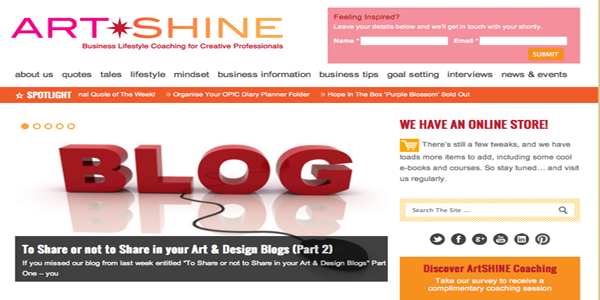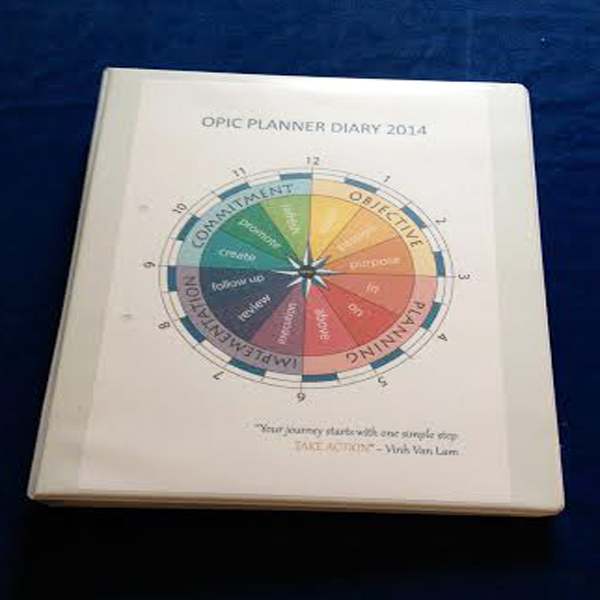1. Stay on topic
Consider a single topic for each blog. Most of your audience will be interested in content that relates to a specific defined topic or a loosely defined area of interest. Your audience won’t care what you had for breakfast in the morning. However, they are more likely to be interested in handy tips or advice. Talk about what you know, and what you’re passionate about. Your audience wants to learn new things and gain personal knowledge. So define a topic and stick to it.
2. Themes
There are a number of approaches that you can take when you’re writing your blog. Here’s some ideas:
• Inspirational blog – you can talk about what or who inspires you to do what you love. It’s also an opportunity for you to welcome new fans, discuss other blogs or websites that inspire you too. You can also post inspirational quotes that resonate with you and your audience.
• Promote what you do blog – talk about your latest or up coming ranges. Share exciting new projects, collaborations with other designers, or joint ventures. Let people know your next exhibition or trade show event. This type of blog is an opportunity for you to let your people know what you are up to in your art and design practice.
• Educational blog – Share your knowledge, skills, and experiences. Position yourself as the leader of your creative field by offering expert tips and advice. Great example like a graphic designer could share his or her photoshop skill.
• Trends forecast blog – What’s in and what’s in demand in your creative field? Materials, colours or techniques? What about new technologies or eco friendly applications etc? Do you have some favourite or useful websites that you can share with your audience?
• Useful information – If you’re attempting to create the impression that you’re an expert in your creative field, then you need to make sure that you’re always up to date the most current news. If you’re endorsing or expressing an opinion, be sure to check your facts too. Your reputation depends on it.
3. Stick to a schedule
Plan your blogging schedule and stick to it. Blogging requires time and effort, so don’t set unrealistic expectations push yourself too hard. An occasional lapse or time off for a holiday is generally acceptable. But the real disappointment for your readers is when they return to your blog only to find old and out of date content.
4. Frequency
Have a think about how many blogs you would like to post each month. A good bench-mark would be two posts per month (fortnightly). Once you’re experienced and have built up a greater following (your fans) then you can post every week. When your blog is updated frequently search engines will tend to pick up your new pages at regular intervals. Set a regular day to publish your blog. That way your readers know when to come back to you and read your blog.
5. Keep it clear and simple
Keep your blog clear and easy to understand. It’s best to steer clear of jargon too. Tell your stories in plain English. And use the language that your audiences can relate to and understand.
6. Embed Keywords
If the objective of your blog is to increase visibility you need to include related keywords in the title and text of your blog. Use the title as a headline to attract interest. Each post needs a title that attracts attention. Aim for a title no longer than ten to twelve words.
7. Engage your readers
Your audience loves to know what you do; that’s why you want to interact with them and ask them to participate with you and the other readers. Ask for feedback or throw in a question or two. Ask for their opinions. Create a forum for your readers too.
8. Quantity matters
To attract the attention of search engines you’ll need to develop your content over time. A single headline or a simple sentence is not going to generate the interest of readers or help you with search engine ranking. Make sure you’re archiving old blog posts too. That way you’ll build a big portal of similar themed content over time.
9. Spelling checks and proof reading
Take a few extra moments and save yourself from having to make embarrassing explanations. Keep in mind that whatever you publish on the net can be found and archived. Think carefully about what you are going to write. Triple check everything.
10. Images and photos
“A picture tell a thousand words”. Pictures and images inspire your readers. A blog with lots of images makes for more interesting and inspiring reading than a long boring essay.
Want to know more?
It’s as simple as 1… 2… 3…
1. Like ArtSHINE’s Facebook page
2. Subscribe to our weekly newsletter
3. Discover ArtSHINE Coaching by taking our survey to receive a complimentary coaching session
Contact Vinh direct:
vinh@artshine.com.au , +61 0410 636 138
FREE Download 2014 OPIC Planner Diary
Limited Time !
If you want 2014 to be your most productive and hit all your goals for the year,
then you’re going to love our brand new OPIC Diary Planner.
Click on this link to get your Planner Diary Free






